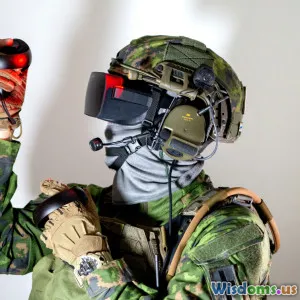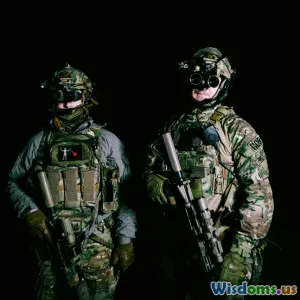
The Rise of Combat Robots Who Really Has the Edge
9 min read Explore the rapid evolution of combat robots and uncover who holds the true advantage in modern warfare. (0 Reviews)
The Rise of Combat Robots: Who Really Has the Edge?
Introduction
In the rapidly evolving landscape of modern warfare, a new contender has stormed onto the battlefield—combat robots. From autonomous drones to ground-based armed machines, robotic warriors are not only changing how wars are fought but challenging traditional definitions of power and control. But amid this technological surge, a core question emerges: who really has the edge when it comes to combat robots—the developers, the deployers, or the machines themselves?
This article explores the cutting-edge rise of combat robots, their technological breakthroughs, strategic implications, and the contest for dominance among global powers. We delve into the real-world examples driving the robotic arms race and analyze the multifaceted challenges and opportunities these systems present.
The Evolution of Combat Robots
From Concept to Combat Field
The integration of robotics in warfare is hardly novel, but the sophistication of today’s combat robots is unprecedented. Early uses focused mainly on bomb disposal and reconnaissance during conflicts like the Gulf War. Today, however, robots are stepping beyond supportive roles into active combatants.
The U.S. military’s use of unmanned aerial vehicles (UAVs) such as the MQ-9 Reaper illustrates autonomy’s gradual but critical role. These drones can conduct surveillance and precision strikes thousands of miles away without risking pilot lives. Ground robots developed under DARPA programs, like the robotic mules and autonomous infantry support vehicles, represent a leap towards land-based autonomy.
Key Technological Milestones
-
Artificial Intelligence (AI): Modern combat robots harness AI algorithms for decision-making in dynamic environments. For example, Boston Dynamics' Spot is capable of navigating complex terrains, while AI combat drones process threat identification in milliseconds.
-
Sensor Fusion: Combining infrared, lidar, radar, and visual sensors allows robots to comprehend their operational environment comprehensively, enabling reactive maneuvers against diverse threats.
-
Robotics Engineering: Innovations in chassis design, materials science, and power management deliver robots robust enough to survive harsh battlefield conditions.
-
Autonomous Weapon Systems: The integration of lethality with autonomy has sparked specialized arms programs, such as Israel’s Harop loitering missile capable of self-guided strikes.
These advancements indicate the maturity of robotic systems from experimental to practical fighting platforms.
Who Holds the Edge? The Major Players
Leading Nations and Key Contractors
Certain countries accelerate ahead, leveraging technological infrastructures and military budgets.
-
United States: The U.S. leads with substantial investment in drone warfare, autonomy research, and robotic infantry systems. Programs like the Loyal Wingman unmanned combat aircraft prototype represent futuristic human-robot teaming.
-
China: China’s expanding military robotics platform emphasizes mass-production of drones and intelligent combat vehicles. The Sky Hunter drone and the AR-1 armed robot patrol reveal aggressive advances.
-
Israel: A pioneer in loitering munitions and unmanned ground vehicles, Israel often sets the bar in real-world battlefield applications.
In industry, companies like Lockheed Martin, Northrop Grumman, and Boston Dynamics push innovation boundaries, while startups harness agility to create niche combat solutions.
Asymmetrical Advantages
-
Speed and Persistence: Robots can operate continuously without fatigue, executing long surveillance missions or rapid-fire operations.
-
Precision and Reduced Collateral Damage: AI-assisted targeting optimizes strike accuracy, reducing risks to civilian populations.
-
Force Multiplication: Robots can extend a small military’s reach, maximizing impact with minimal personnel.
However, reliance on high-end technology can breed vulnerabilities like hacking risks or system malfunctions.
Ethical and Strategic Concerns
Automation Versus Human Control
The shift toward autonomous weaponry inevitably challenges moral boundaries. Debates rage over “killer robots” making life-and-death decisions without human oversight. The Campaign to Stop Killer Robots emphasizes the need for international bans on weapons systems that operate without meaningful human control.
Rules of Engagement and Accountability
Identifying responsibility when robotic weapons cause unintended casualties remains complex. Current international laws lag behind technology, creating ambiguities in deployment rules.
Potential for Escalation
Robotic warfare could lower the threshold for conflict initiation due to less immediate human cost, increasing the risk of rapid and unintended escalations.
Tactical Edge: Robots Versus Humans?
Machine Strengths
-
Endurance and Resilience: Combat robots are impervious to fatigue and some environmental hazards, enduring longer in hostile zones.
-
Data Processing: Instantaneous data analysis enables robotic systems to adapt faster than humanly possible.
-
Access to High-Risk Areas: Robots can infiltrate contaminated or heavily fortified zones too dangerous for soldiers.
Human Strengths
-
Judgment and Creativity: Humans excel at making nuanced strategic decisions amidst uncertainty and unexpected conditions.
-
Ethical Reasoning: The moral compass provided by human oversight remains vital where ambiguous situations arise.
Human-Robot Teaming
Modern doctrines favor hybrid teams, leveraging the strengths of both. For instance, the U.S. Air Force’s manned-unmanned teaming concept pairs pilots with unmanned aircraft to mutually augment battlefield effectiveness.
The Future Landscape of Combat Robotics
Artificial General Intelligence (AGI) and Robotics
The advent of AGI could revolutionize combat robots’ capabilities, enabling broad context understanding and adaptive battlefield tactics independent of strict programming.
Swarm Technologies
Swarm robotics—large groups of smaller drones working cohesively—offer unprecedented offensive and defensive potential. These swarms can overwhelm enemy defenses through sheer numbers and coordination, illustrated by ongoing research at the Defense Advanced Research Projects Agency (DARPA).
Cybersecurity and Electronic Warfare
Future combat robots must confront cyber threats aimed at disabling or commandeering units. Continuous innovation in cybersecurity defenses will be critical to maintaining battlefield supremacy.
Regulatory and Diplomatic Responses
Expect new treaties and international agreements focused on controlling the proliferation and use of lethal autonomous weapons to prevent destabilization.
Conclusion
The rise of combat robots marks a transformative era in warfare reshaping the very nature of conflict. While technological breakthroughs afford unparalleled advantages in precision, endurance, and battlefield awareness, they pose daunting ethical dilemmas, cybersecurity challenges, and strategic uncertainties. The edge in robotic warfare does not solely belong to the machines or their creators but to those who best integrate technology with human judgment, ethical frameworks, and tactical innovation.
As nations rush to build the future battlefield, collaboration among technologists, policymakers, and ethicists will determine whether combat robots emerge as instruments of stability or uncontrollable forces of disruption. Ultimately, understanding the rise and implications of these systems equips global actors—and laypersons alike—to face the challenges and opportunities of 21st-century warfare with clarity and preparedness.
"Robotics does not replace the soldier; it supercharges the strategist." — Military Technology Analyst
References & Further Reading
- Singer, P.W. (2009). Wired for War: The Robotics Revolution and Conflict in the 21st Century. Penguin.
- Cummings, M.L. (2017). "Artificial Intelligence and the Future of Warfare." Chatham House Report.
- International Committee of the Red Cross. (2023). Autonomous Weapons and International Humanitarian Law.
- DARPA Official Website – Robotics Challenges and Developments.
- Campaign to Stop Killer Robots – www.stopkillerrobots.org
Images and infographics by Defense Imagery Archives and Open Source Intelligence Consortium.
Rate the Post
User Reviews
Other posts in Artificial Intelligence
Popular Posts















